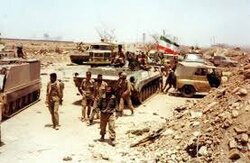Terms & Concepts
The Siege of Abadan
Mohsen Shir-Muhammad
207 Views
In October 1980, Abadan came under siege by Iraqi forces and was eventually liberated after 349 days during Operation Thamen al-Aemmah (as). Abadan, one of the key ports of Khuzestan Province, is bordered to the north by Khorramshahr, to the east by Mahshahr, to the south by the Persian Gulf, and to the west by Iraq. The city is surrounded on three sides by the Karun, Bahmanshir, and Arvand rivers, and on the south by the Persian Gulf, effectively turning it into an island. Due to its geographical and strategic significance, Abadan was one of Iraq’s primary targets during its invasion of Iran on September 22, 1980.[1]
At the onset of the Iran-Iraq War, the Iraqi army, unable to cross the Arvand River and hindered by the firm resistance of Khorramshahr’s defenders, planned to occupy Abadan by crossing the Karun River in the Marad area and advancing towards the Bahmanshir River.[2] On October 10, 1980, Iraq’s 6th Armored Division built a bridgehead from the Karun River to the Ahvaz–Khorramshahr Road, approximately 2 kilometers wide. They installed a PMP floating bridge across the Karun and fortified the area east of the river. Three days later, the Iraqis advanced towards Marad, north of Abadan, and captured it. The next morning, they took control of the Mahshahr–Abadan Road thereby effectively laying complete land siege to the city.[3] Thus, Iraq gained a strategic foothold east of the Karun River and began expanding it to gain full access to Abadan.[4]
After the Iraqi troops crossed Karun, three defensive lines were formed at the eastern side of the river: the Abadan front (14 km long), the Darkhovein front (50 km), and the Mahshahr front (7 km).[5]
On October 21, 1980, the Arvand Headquarters (command center for armed forces in Khorramshahr and Abadan)[6] was established in Mahshahr under the command of Colonel Hassan-Ali Foroozan, the commander of the national gendarmerie. Operational command of Abadan (a division of Arvand Headquarters) was entrusted to Colonel Hussain Hussaini Sadi.[7]
In late October 1980, following the siege of Abadan, the 153rd Battalion of the 77th Division of the Army was deployed to the region via sea using hovercraft and helicopters.[8] On October 31st, this unit engaged Iraqi forces in the Zolfaghari area of Abadan and defeated them, preventing the city’s fall.[9]
At that time, the forces defending Abadan included the remaining troops of the 151st Dezh (Khorramshahr) Battalion, the 165th Armored Battalion, the 232nd Tank Battalion (of the 92nd Division of the Army)[10], the 153rd Battalion of the 2nd Brigade of the 77th Division of the Army, 200 Army Navy commandos, 350 Islamic Revolutionary Guard Corps (IRGC) fighters from Abadan, 2000 Basij forces from the city, and 150–200 volunteers from other counties, including the Fadayan-e Islam Group led by Seyyed Mojtaba Hashemi.[11] Moreover, there were 150 members of Tehran’s Fourteen Revolutionary Committees, 150 IRGC forces from Shiraz, 70 gendarmerie personnel from Abadan, some police officers from Abadan and Qom, and tribal Basij forces from Kohgiluyeh and Boyer-Ahmad Province.[12]
During the siege, all movements to and from Abadan took place through Imam Khomeini (ra) Port located next to the Mahshahr.[13] Multiple teams were mobilized to deliver troops and supplies to Chavibdeh Port (southeast of Abadan), which played a crucial role in supporting the city. These included civilian barges and tugboats, Army Aviation and Navy helicopters, port vessels from Imam Khomeini (ra) Port Authority, and the Army hovercrafts. A landing zone for helicopters was built in Chavibdeh, and given the large capacity of the helicopters, they transported ammunition, weapons, and troops from Mahshahr to Abadan. On their return trips, priority was given to the wounded, and sometimes the martyrs or soldiers who wanted to return to Mahshahr. In the siege of Abadan, the port city of Mahshahr became the critical logistical bridge connecting Mahshahr to Abadan.[14]
On October 25, 1980, the 144th Battalion of the 21st Division (Army) launched an operation to liberate the Ahvaz–Abadan Road and break the siege of Abadan. The operation, however, ended in failure.[15] On November 5, 1980, following the Army’s inability to push the enemy back from the eastern bank of the Karun River, Imam Khomeini (ra) issued a direct order to break the siege of Abadan. In response, on January 10, 1981, another operation named Tavakkol was carried out jointly by the Army and the IRGC along the Mahshahr–Abadan Road, but that also failed to achieve its objectives.[16]
During the siege, the main administrative offices in Abadan such as the governor’s office, municipality, water and electricity department, and telecommunication facilities remained operational.[17] However, due to repeated bombings and daily shelling, the city’s infrastructure was in disarray. Water treatment facilities belonging to the National Iranian Oil Company and the municipality, located along the Bahmanshir River, were damaged, cutting off the city’s water supply. Although limited quantities of treated drinking water were delivered to the city by sea via barges, fighters were often forced to use water from the Bahmanshir River for drinking and cleaning, even though it was filled with the decomposing bodies of Iraqi soldiers. Electric substations were also damaged, leaving the city without electricity. Moreover, the enemy’s occupation of the strategic Abadan–Ahvaz and Abadan–Mahshahr roads led to the disruption of high-voltage power lines. Consequently, electricity for critical locations including hospitals, war headquarters, and certain command centers was supplied by generators.[18] Despite the Abadan oil refinery burning continuously, refinery workers managed to extract fuel from intact tanks to meet vehicle fuel demands. In fact, shortages in Ahvaz and its surrounding areas were sometimes dealt with by using the remaining fuel reserves of Abadan.[19]
Due to food shortages, the Iranian forces had to use dry bread and other food items brought into Abadan by sea. Because of the region’s humidity, much of the food became moldy or spoiled. Therefore, to deal with the issue the authorities asked the owners of grocery stores, pharmacies, and bakeries to open their shops. Then, inventories were documented and goods were purchased from them in cash.[20]
Civilians who had left Abadan at the onset of the war later returned to Mahshahr to take their belongings. A logistics committee was established to supervise and control the movement of the people’s goods.[21]
From the earliest days of the war, part of the main Khorramshahr–Abadan Road had fallen into Iraqi hands and remained under their firepower, making it impassable for Iranian forces. The deployment locations of the 77th Division of the Army and other units around Abadan were such that aerial supply was both costly and dangerous, while delivery via marshes and narrow waterways was slow and inefficient. To solve this logistical challenge, in early summer 1981, as the weather warmed up and monsoon rains faded, the combat engineering battalion of the 77th Khorasan Division of the Army, in collaboration with the Jahad-e Sazandegi Organization of Fars Province, transported about 5000 truckloads of gravel to build a new road behind the defensive lines. This route, later named the Vahdat Road, was completed in late July 1981. It connected Abushanak, on the banks of the Bahmanshir River, to the Shadegan junction (at kilometer 17 of the Abadan–Mahshahr Road), significantly facilitating the deployment of troops and equipment to Abadan.[22]
In early 1981, the 77th Division assumed command over the Abadan and Khorramshahr region and began planning an operation to break the siege.[23] According to the plan—later known as Operation Thamen al-Aemmah (as)—Brigades 1, 2, and 3 of the 77th Division, along with IRGC units, were tasked with liberating occupied territories east of the Karun River.[24]
On September 27, 1981, the operation began. Brigade 1 launched its assault from the Zolfaghari region, Brigade 2 from Fayyazieh, and Brigade 3 from Darkhovein. After two days of fierce fighting, Iraqi forces were pushed out of the eastern bank of the Karun. After the operation, the captured Iraqi soldiers marched before Iran’s senior military commanders, and Brigadier General Seyyed Shahabuddin Javadi, the commander of the 77th Division who led the operation, made a speech in Arabic to the prisoners.[25] In this way, Abadan was finally liberated after the 349-day siege.[26]
During President Bani-Sadr’s tenure, two operations had been launched to break the siege of Abadan both of which were failed. Following Bani-Sadr’s dismissal from the position of Commander-in-Chief on June 22, 1981, and Imam Khomeini’s earlier order on November 5, 1980, to break the siege, a joint operation by the Army, the IRGC, and popular forces was successfully launched ending the siege after 349 days.[27]
[1] Tam, Somayeh, Shekast-e Hasr-e Abadan (Breaking the Siege of Abadan), Daneshname-ye Emam Khomeini, Vol. 6, Pp. 446–451, https://fa.wiki.khomeini.ir/wiki/%D8%B4%DA%A9%D8%B3%D8%A8%A2%D8%AF.
[2] Pourjabari, Pejman, Atlas-e Joghrafiya-ye Hamaasi - Khuzestan dar Jang (Geographical Atlas of Heroism - Khuzestan in War), Vol. 1, Tehran, Sarir, 1389, p. 195.
[3] Banilohi, Seyyed Ali va Digaran, Nabardha-ye Sharq-e Karun be Revayat-e Farmandehan (Battles of East Karun as Narrated by Commanders), Tehran, Markaz Motaleat va Tahqiqat Jang Sepah Pasdaran, 1379, p. 54
[4] Ibid., p. 55.
[5] Ibid., Pp. 75, 76.
[6] Soleimanikhah, Nematollah, In Su-ye Arvand Jayi Baraye Doshman Nist (There is no Place for the Enemy in this Side of Arvand), Tehran, Markaz Asnad va Tahqiqat Defa Muqaddas, 1393, p. 351.
[7] Ibid., p. 351.
[8] Shirmuhammad, Mohsen, Niru-ye Daryayi (Naval Force), Daneshname-ye Elektroniki Wiki-ye Defa, https://wikidefa.ir/?page=result.
[9] Soruri, Rouhollah va Abolqasem Javdani, Amaliat-e Thamen al-Aemmah (as) (Operation Thamen al-Aemmah (as)), Tehran, AJA, 1390, Pp. 69, 70.
[10] Soleimanikhah, Nematollah, p. 351; Vaqti Yek Lashkar Irani Moqabel-e 6 Lashkar-e Araqi Istad (When One Iranian Division Stood against Six Iraqi Divisions), Sit-e Markaz Asnad Enqelab Eslami, 1 Mehr 1396.
[11] Orooji, Akram, Fadaiyan-e Eslam (Fadayan-e Islam Group), Daneshname-ye Elektroniki Wiki-ye Defa, https://wikidefa.ir/?page=result.
[12] Soleimanikhah, Nematollah, Ibid., p. 393.
[13] Emdadresani be Abadan dar Zaman-e Mohasere-ye In Shahr (Helping Abadan during the Siege), Paygah-e Tahlili Khabari Basirat, 12 Mehr 1400.
[14] Ibid.
[15] Pourdarab, Saeed, Taqvim-e Tarikh-e Defa Muqaddas - Polhaye Taskhirnapazir (Chronology of the Sacred Defense – Invincible Bridges), Vol. 3, Tehran, Markaz Asnad Enqelab Eslami, 1385, Pp. 64–66.
[16] Jafari, Mojtaba, Atlas-e Nabardhay-e Mandegar (Atlas of Lasting Battles), Tehran, Sura Sabz, 1393, Pp. 40, 64.
[17] Habibi, Abolqasem, Atlas-e Rahnama - Abadan dar Jang (Atlas – Abadan in War), Tehran, Vol. 6, Markaz Motaleat va Tahqiqat Jang Sepah Pasdaran, 1382, p. 95.
[18] Soleimanikhah, Nematollah, Ibid., p. 394.
[19] Ibid., p. 395.
[20] Ibid.
[21] Ibid., p. 396.
[22] Raminnejad, Ramin, Tarikh-e Lashkar-e Khorasan - Az Piruzi-ye Enqelab Eslami ta Pas az Doran-e Defa Muqaddas (History of the Khorasan Division – From the Victory of the Islamic Revolution to Post-Sacred Defense Era), Vol. 2, Mashhad, Ahang Qalam, 1391, p. 82.
[23] Soruri, Rouhollah va Abolqasem Javdani, Ibid., Pp. 88, 89, 124.
[24] Banilohi, Seyyed Ali va Digaran, Ibid., p. 176.
[25] Jafari, Mojtaba, Ibid., p. 64.
[26] Habibi, Abolqasem, Ibid., p. 125.
[27] Tam, Somayeh, Ibid., Pp. 446–451.





